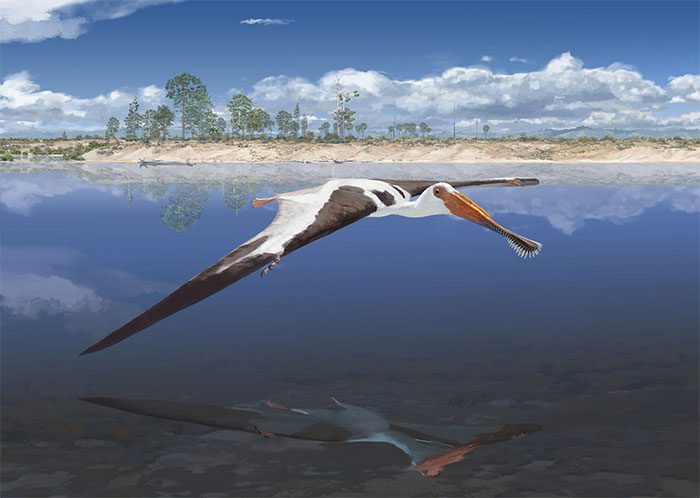A fossil of a new Jurassic monster has just been unearthed in Portugal, featuring an oversized body and the ability to fly.
Similar to most of the bizarre creatures that once roamed the skies during the “Age of Monsters,” which spanned the Triassic, Jurassic, and Cretaceous periods, this creature is a reptile, not a bird, despite its flying capability.
According to Sci-News, the strange creature has been named Lusognathus almadrava, identified as belonging to a subgroup known as Gnathosaurinae, which includes large and extremely fearsome pterosaurs.

Lusognathus almadrava flying in the Jurassic sky – (Graphic: Jason Brougham)
Pterosaurs are close relatives of dinosaurs, but rather than walking on the ground, they dominated the skies and are also known as “winged lizards.”
According to Dr. Octávio Mateus from the Lourinhã Museum and the GEOBIOTEC unit at Nova University in Lisbon (Spain), pterosaurs are an incredibly diverse group of creatures found all over the world, including Antarctica. However, studying them poses many challenges due to the relatively sparse fossil record.
Among these, the fossils that paleontologists most desire to find are those of oversized pterosaurs from the early Triassic-Jurassic period.
In contrast to the Cretaceous pterosaurs, which often had wingspans reaching up to 3 meters, the earlier pterosaurs only had wingspans of 1.6 to 1.8 meters, which is equivalent to or smaller than that of a modern bald eagle (with a wingspan of about 1.8 to over 2.3 meters).
However, there has long been a hypothesis that giant pterosaurs existed earlier.
The creature recently unearthed is an example. Although only part of its head has been found, calculations suggest that this creature must have had a wingspan of 3.6 to 4 meters, significantly larger than Cretaceous pterosaurs.
According to a paper published in the journal PeerJ, these findings have helped refine the evolutionary picture of pterosaurs, indicating that the time when they evolved to become giant could be at the end of the Jurassic period, rather than the beginning of the Cretaceous period as previously predicted.
The authors suggest that the remarkable growth of these flying monsters may have been a competitive response to a new lineage that had just diverged from the dinosaur family tree and evolved in an entirely different way: birds.
Dating back 149 million years, this fossil is also contemporaneous with the Archaeopteryx, also known as “proto-bird.”


















































